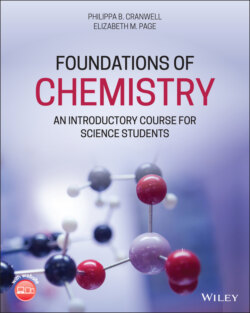Читать книгу Foundations of Chemistry - Philippa B. Cranwell - Страница 10
Preface
ОглавлениеFoundations of Chemistry is a concise course in advanced general chemistry specifically designed for students studying at Level 3 (A level or equivalent). It is especially relevant for students enrolled upon one‐year foundation programmes catering for physical and life sciences provided by UK universities, and is intended to introduce students to the core elements of physical, organic, and inorganic chemistry. The text outlines the basic principles in each area of chemistry and builds on prior knowledge from GCSE (or equivalent) courses to quickly expand and develop students' knowledge and understanding. Each chapter contains worked examples that showcase core concepts, and includes practice questions with fully worked answers available on the Wiley website. Margin comments signpost students to knowledge that is covered elsewhere in the book and are used to highlight key learning objectives when appropriate. A summary is given at the end of each chapter that lists the main concepts and learning points.
The authors recognise that many students on foundation programmes study chemistry as a subsidiary subject. We hope that this text outlines and clearly explains the information and knowledge required at foundation level so that these students can progress smoothly onto their parent programmes.
Students are first introduced to the structure of the atom and how the periodic table is built up. The different types of bonding are then described, followed by the way in which the properties of materials are affected by bonding within and between molecules. The fundamentals of physical chemistry including thermodynamics, equilibria, acids and bases, reaction rates, redox, and electrochemistry are explained. Elements and typical compounds from some key groups in the periodic table are considered in more detail, with specific reference to the underlying principles of periodicity and energetics where relevant. Organic chemistry takes a mechanistic approach, so students are able to rationalise reactivity and chemical behaviour; the intention is not for students to learn by rote, but to be able to apply their knowledge and understanding to derive an answer. This skill can be developed by students in a chapter dedicated to synoptic questions in organic chemistry. Finally, a chapter dedicated to spectroscopy demonstrates how modern analytical techniques are used in organic chemistry to determine structure.
The book is concise and focusses on key ideas, yet points students to areas that they may meet if they continue to study chemistry.
Philippa Cranwell and Elizabeth Page
Reading, UK
